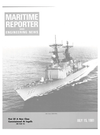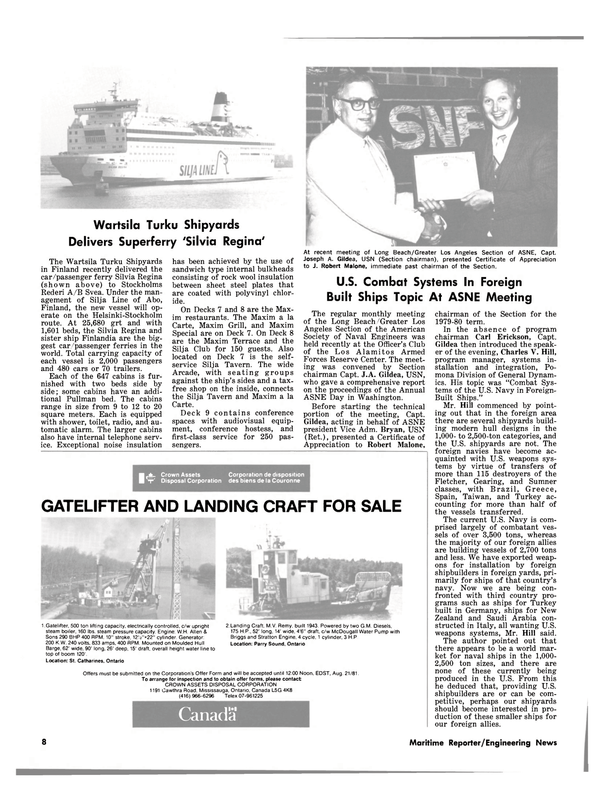
Bay Building Barge With First Conveyor To Handle Wet Phosphate Rock
6Construction is under way on a seagoing barge that includes in its equipment the first loop-belt type self-unloading conveyor system specifically designed to handle blended wet phosphate rock.
The 610- by 78-foot barge is being built by the Bay Shipbuilding Corporation, Sturgeon Bay, Wis., for the Beker Shipping Company of Greenwich, Conn. The loop-belt self-unloading equipment and related machinery is being supplied by Stephens-Adamson, Inc., an Allis-Chalmers Corporation subsidiary.
The barge is of tug notch design, in which the stern is fitted with a deep notch to accommodate a 7,200-bhp tug that propels the barge. The all-welded barge will be used to transport phosphate rock between Tampa, Fla., and a Mississippi River port.
A loop-belt, self-unloading conveyor system is a development of Stephens-Adamson that is used extensively on Great Lakes bulk carrier freighters. The system involves a double set of conveyor belts that are sandwiched togeth- er by rollers in order to permit bulk material to be elevated from a lower level, as a ship's hold, to a higher level for discharge. The arrangement is very compact, freeing ship's space for payload.
Wet phosphate rock is a term used in the industry to describe phosphate ore that has been cleaned by washing and screening, but has not yet been converted into usable fertilizer. Physically, it resembles beach sand.
The system on the Beker Shipping barge is rated 4,500 short tons an hour and has a 68-foot lift.
The barge also will be outfitted with 35 units of recently developed Stephens-Adamson bulk flow gate used in releasing bulk materials from ship's hoppers. These are used with a conveyor that traverses the 495-foot-long cargo hold, bringing rock to the loopbelt unit. A boom with a conveyor will move the rock from the loopbelt discharge to hoppers ashore.
Read Bay Building Barge With First Conveyor To Handle Wet Phosphate Rock in Pdf, Flash or Html5 edition of July 15, 1981 Maritime Reporter
Other stories from July 15, 1981 issue
Content
- Bay Building Barge With First Conveyor To Handle Wet Phosphate Rock page: 6
- Robert Ware Establishes His Own Maritime Public Relations Service page: 7
- Circular Detailing New Suez Canal Regulations Available From Candia page: 7
- IMODCO Receives Order From Petrobras For $5-Million SPM Terminal page: 7
- Wartsila Turku Shipyards Delivers Superferry 'Silvia Regina' page: 8
- U.S. Combat Systems In Foreign Built Ships Topic At ASNE Meeting page: 8
- Puget Sound Tug & Barge Will Build 12 Barges Costing $39.5 Million page: 9
- Seaco Energy/Coastal Carriers Joint Venture Plans Floating Terminals page: 9
- First Of New Destroyer Class Commissioned At Ingalls Yard page: 10
- Santa Fe Diving Services Awarded Contract To Provide RCV And Crew page: 10
- National Steel Lays Keel For U.S. Navy Cable Repair Vessel page: 10
- Second Crandali Dock At National Sea Products Yard Rebuilt And Enlarged page: 12
- Anthony McAllister Jr. Elected Chairman Of New York Towboat Association page: 14
- $172-Million Navy Order To Bell For New Type Landing Craft page: 14
- Theriot-Modec To Build Ammonia Barge For Energy Transportation Subsidiary page: 15
- Edward Campbell Named To Board Of Trustees At Webb Institute page: 15
- $140-Million Contract For Two Offshore Rigs Awarded To Gotaverken Arendal Shipyard page: 16
- Benson, Basse And David Join Tampa Barge In Management & Production page: 16
- Delaware Valley ASNE Chapter Discusses Government Contracting page: 16
- Hudson Delivers The 'Gulf Dolphin7 To Gulf Fleet Marine page: 18
- Third Seaboard RO/RO Ordered At Fredriksstad Yard Will Have MacGregor Hoistable Decks page: 18
- Grumman Hydrofoil For Israel Launched At Lantana Boatyard page: 20
- Dravo-Built Towboats For China Get A Lift From Dock Express page: 20
- Petronio Elected VP-Engineering At Pool Company Of Houston page: 21
- Two MARCO Oil Skimmers Delivered To Mexican Navy page: 21
- David Taylor Naval R&D Center Hosts Hydromechanics Meeting page: 22
- W.B. Buhrmann Elected President Of Newly Formed U.S. Steel Companies page: 24
- Valley Line Asks Title XI For $90.1-Million Barge And Towboat Project page: 24
- Petro Marine Services To Build $25-Million Shipyard In Alaska page: 26
- Riverway Completes Second Drydock For Its Own Repair Division page: 27
- New Brochure Describes National Crane's Line Of Marine Lifting Systems page: 27
- Shipyard Conference Honors Past Chairmen McKay And Pirozzolo page: 28
- HUDSHIP To Build Four Big Towing/Supply Vessels For Zapata page: 29
- U.S. And Canada Agree To Cooperate In Marine Transportation R &D page: 34
- Philadelphia Resins' New Brochure Describes The Company And Its Products page: 34
- Griffin & Alexander Jackup Rig Commissioned At Bethlehem-Beaumont page: 35
- Lima Electric Announces New Model Alternator- Literature Available page: 35
- Raytheon Opens New Marine Sales And Service Facility In Mississippi page: 36
- Partnership Between AMCA International & McDermott Formally In Business page: 36
- Seminars On Rig Moves Organized By Marine Design International page: 37
- Dome Acquires Davie Shipbuilding At Total Cost Of $38.6 Million page: 38
- Riverway Shipyard Delivers GM-Powered Towboat 'Waterways Explorer7 page: 38
- Largest DMI Dredge Delivered To Mexican Owner page: 39
- Rubber Fendering Reduces Damage To Vessels And Piers page: 40
- Sembawang Yard Completes Multimillion-Dollar Overhaul Job On McDermott Barge page: 40
- APL Ready To Build 45-Foot Production Unit Containers page: 41
- Tracor Marine Awarded $2.5-Million Navy Contract To Manage OCEI Facilities page: 42
- Ned Smith Named Vice President-Finance For American Steamship page: 42
- Dravo To Provide People's Republic With Technical Assistance And Equipment page: 42
- McDermott Incorporated Promotes Four To « Vice President Posts page: 43
- Multipurpose Cargo Vessel Launched At GHH Sterkrade Yard page: 44
- New York Maritime Day Ceremonies Featured Presentation Of Two Awards page: 58
- Todd Shipyards Awarded Navy Study Contract On DDGX Producibility page: 58
- Butterworth Tank Washing Machines Ordered For Eight New Product Carriers page: 59
- Bulk Carrier 'Star Of Texas7 Launched At Levingston Yard page: 59


